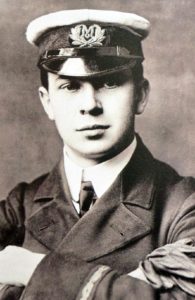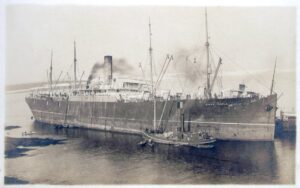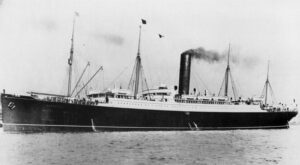by Carl Kruse
Years ago I studied Morse Code as a prerequisite to becoming a Ham radio operator and while never becoming a Ham I abosrbed Morse Code and wondered recently if I could still interpret the dit-dah of the dots and dashes. Feeling perhaps like those former guitarists who wonder if they can still finger an F chord.
Rummaging online for Morse Code signals I found practice manuals, equipment, old movies, live transmissions and tips. Glory be the Internet. Is there nothing it does not hold? This was all the more unusual as Morse Code is no longer used or required for anything, anywhere as far as I know.

An interesting Morse transmission surfaced — the original distress signal from the Titanic, from just moments before it struck the iceberg until it sunk. The wireless operator, Mr. Jack Phillips, who celebrated his 25th birthday the day after the Titanic departed from port, stayed at his post during the disaster and went down with the ship, though there are differing accounts of his fate and his body was never found. As an aside, Phillips was reported busy clearing a backlog of delayed messages because of a breakdown of the ship’s wireless equipment and is blamed by some for the disaster itself by ignoring or failing to relay vital messages concerning ice warnings from other ships to the bridge, though most historians agree that once disaster struck, Phillips gallantly did his all until the end.

The hair-raising transmission of Titanic‘s distress signal — a re-creation of it that is — can be found here: Titanic’s Morse Code and Text Transmission.
To my chagrin the stream of dit-dahs dit dahs was mostly undecipherable, an alien staccato, and I quickly came to admire those fleet of pulse who fluently conversed in that strange, rapid-fire, mechanical brevity of the original code, even throwing slang into their dots and dashes, as they referred to fellow young wireless operators as “old man” rapping on the telegraphic key. Subtitled Morse Code makes it easy to follow what transpires.
In the early morning of April 15, 1912 as the ship sailed from Southampton to New York, transmissions from Titanic‘s Marconi Room — the wireless center — were nondescript and ordinary. And is it not how life”s catastrophes are announced? Everything normal until suddenly not.
At 12:15 a.m. we read, or better said hear:
TITANIC TO CAPE RACE:
TO HARRISON SANDFORD, NEW YORK
HELLO BOY. DINING WITH YOU IN SPIRIT TONIGHT.
HERE WITH YOU ALWAYS.
BEST LOVE, GIRL
The next message begins:
TITANIC TO CAPE RACE:
GEORGE SIMUND, NEW YORK
WEATHER DELIGHTFUL. FEELING FINE.
HOPE ALL
And the transmission suddenly cuts off. A few seconds of silence. Then a call for help.
CQD THIS IS TITANIC
CQD THIS IS TITANIC
CQD THIS IS TITANIC
CQD THIS IS TITANIC
POSITION 41.44N 50.24W
Though SOS was adopted in 1908 as an international symbol for distress, few radio operators in 1912 used it in practice, and neither did Mr. Philipps, who used the older “CQD” for emergency. The letters “CQ” signaled a general call, such as “Attention All Stations” with the letter “D” indicating distress. It was not until after the Titanic disaster that SOS became widely adopted. As an aside and contrary to popular belief, the initials “SOS,” do not stand for “Save our Souls” or “Save Our Ship.” SOS was adopted because the three dits of “S” following the three dahs of “O” easily and quickly stand out for any receiver. And so they do.
SOS in Morse Code:

The three-letter code is transmitted faster than imagined. SOS — and only SOS — has no break between letters as in a normal transmission. Letters are tapped rapid fire one after the other. It sounds like this:
SOS – SOS – SOS – SOS
Why not take a moment and try tapping out SOS with one finger. Just a few seconds. Dit-dit-dit-dah-dah-dah-dit-dit-dit. Can you get the cadence? Even after some telegraphy training I still can’t get it just right. Three letters in Morse Code. Three dots, three dashes, three dots, encapsulating all of one’s hope and fear.
A brief regression and now back to the Titanic‘s transmission. The ship SS Mount Temple is the first to respond to the distress call asking what is the matter and Philipps informs them that they have struck an iceberg.
Soon thereafter the RMS Carpathia, the ship that would be the first to eventually reach the Titanic, chimes in asking if the Titanic needs help. Philipps replies tersely via code “YES. COME QUICK.”
(ASIDE: Both Mount Temple and Carpathia were sunk a few years later by German U-boat action in World War I).
Other ships including the Frankfurt, the Ypiranga, the Caronia, the Olympic, the Californian, the Virginian, the Baltic and the Birma, can be heard relaying messages or in the case of the Birma being informed by the Titanic that she is actually sinking.
At 12:30 a.m. the Mount Temple transmits, “OUR CAPTAIN REVERSES SHIP. WE ARE ABOUT 50 MILES OFF.”

To add to the chaos, Philipps can barely here the dits and dahs from the other ships as he tells the others “FOR RUSH OF AIR AND NOISE OF STEAM.”
At 12:40 a.m. just as lifeboat Number 7 is launched from the Titanic the Carpathia signals, PUTTING ABOUT AND HEADING FOR YOU. EXPECT TO ARRIVE IN FOUR HOURS.”
At 12:45 a.m. for the first time Philipps uses the actual SOS code, adding to the CQD signals he has been sending until now as he pleads for assistance. His transmissions become more desperate as he indicates “SINKING FAST.”
At 1:05 a.m. as more lifeboats are launched from the Titanic there is a cacophony of multiple transmissions with signals jamming each other.
The Baltic signals at 1:15 a.m., PLEASE TELL TITANIC WE ARE MAKING TOWARDS HER. WE ARE 243 MILES EAST OF TITANIC. This is followed at 1:20 a.m. with the Virginian transmitting, WE ARE GOING TO TITANIC’S ASSISTANCE. WE ARE 170 MILES NORTH OF TITANIC.
At 1:30 a.m. Philipps desperately transmits, WE ARE PUTTING THE WOMEN OFF IN BOATS. WE ARE PUTTING THE PASSENGERS OFF IN SMALL BOATS. WOMEN AND CHILDREN IN BOATS. CANNOT LAST MUCH LONGER. LOSING POWER. Followed in five minutes with repeated transmissions of ENGINE ROOM FLOODED. The Baltic responds WE ARE RUSHING TO YOU followed by Olympic‘s AM LIGHTING UP ALL POSSIBLE BOILERS AS FAST AS WE CAN.
At 1:48 a.m. for the first time since transmitting, Philipps sends three SOS signals in a row along with several CQDs and almost anyone can recognize the operator’s code here. Three dits for “S,” followed by the three dahs for “O” and another three for “S,” all in rapid-fire pulse. Repeated. Exhilarating and chilling to grasp during the frenetic action.
In response to Philipps’ frantic messaging the Carpathia responds, ALL OUR BOATS ARE READY. WE ARE COMING AS HARD AS WE CAN OLD MAN. DOUBLE WATCH ON ENGINE ROOM. HAVE YOUR LIFEBOATS READY FOR WHEN WE ARRIVE.
At 2:10 a.m. Philipps transmits WE ARE SINKING FAST.
And finally, the last haunting transmission at 2:17 a.m.,
CQD THIS IS TITANIC. CQD THIS IS
The Titanic would completely sink three minutes later with the loss of more than 1500 people. The Carpathia finally arrived around 4:00 a.m rescuing about 710 people. Philpps and the rest of the people who did not survive were just 1 hour and 45 minutes from being rescued.

The entire telegraphic stream from start to finish lasts about an hour instead of the original two hours in real life because duplicate messaging and dead air was removed. If you don’t think you can sit in front of a YouTube screen listening to Morse Code for an hour you might be in for a surprise. It’s riveting and a front seat to history. While I was disappointed I could not follow the Morse Code itself by ear, I was thrilled that modern technology could recreate the final moments of the Titanic, of Philipps desperately urging the first responders to come quickly. Independent of interpreting telegraphy, seeing how rapidly life can change — with momentous consequences — in a moment. Is it not always so? Steady as she goes and then an iceberg appears out of nowhere.
Head over and hear the power of the dit-dahs. If you do, would you leave a comment with your thoughts below?
Here’s to never having to face what Philipps and the rest of those aboard the Titanic faced.
Carl Kruse
Contact: carl AT carlkruse DOT com
More about Carl Kruse
P.S. For further time travel to another era the U.S. Army Signal Corps “Morse Code Lesson 1” is a rough and ready course on telegraphy and if nothing else a quirky historical trip. Check it out at https://www.youtube.com/watch?v=lwsiMm4sxpk . Quickly learn that dits must be uniform and short. Dahs uniform and long. Each letter with a distinctive beat, like the galloping sound of the four dits of letter “H” — dit-dit-dit-dit — “like a horse in a hurry!” Or the two step dance of letter “I” dit-dit. The entire video is about 10 minutes long and a gem for anyone interested in Morse Code or time travel. If you liked part 1, there is also a part 2 — “Morse Code Lesson 2.” The link is available within Lesson 1.
My last blog post was on the Meditations by Marcus Aurelius.
Just finished listening to the Titanic Morse Code transmission. Wow. We live in a special time where I can sit back at home with a glass of wine in hand and commune with some of the key figures of the Titanic tragedy. Thank you for sharing Carl Kruse.
Happy it was a good experience Michaela and thanks for your kind words!
-Carl Kruse
Friggin bone-chilling stuff there Kruse. And you are right. I watched everything start to finish and recommended it to my wife. Didn’t seem like it was an hour. Incredible.
The hour went by in a flash for me. So worth it. Glad you liked it as well Cody. Thanks for the kind words.
– Carl Kruse
Haunting and spooky. And how quickly everything went down, literally!
Life can come at you pretty fast, no?
– Carl Kruse
Dit dit dit dah dah dah dit dit dit Dit dit dit dah dah dah dit dit dit I didn’t hear it often but it jumped right out and grabbed you when the telegrapher keyed it.
S-O-S (dit dit dit – dah dah dah – dit dit dit) chilling indeed.
* Carl Kruse *
Wow. And wow. That was cool.
Many thanks Doobster!
– Carl Kruse
You asked that whoever went to listen to the transmission come back and comment.
I just finished listening and wanted to thank you for suggesting it. Not a normal thing I would have done on a Tuesday morning. 🙂
That’s cool you headed over and checked it out Elaine and I’m happy it didn’t disappoint. Thanks for your kind words.
Carl Kruse
Wowzers. I can’t imagine what it must have been like to be aboard the Titanic and know that there were not enough life rafts. And bravo to the radio operator and the rest of the crew that worked to save those they could. And thanks Carl Kruse for sharing.
And thank you for stopping by Luther. Hard to imagine what it must have been like aboard the ship.
Carl Kruse
It is an astonishing account. Just wondering, of those messages immediately before the CQDs began, do we know what happened to those who sent them?
Did George Simund see the sender of the message addressed to him?
Did Harrison Sandford (‘Boy’) ever get to dine in person with ‘Girl’ who was thinking of him with love as she dined on the Titanic?
Haunting questions indeed David Gardiner. And how life can change instantaneously moment to moment.
Thanks for stopping by and for your thoughtful commentary.
Cheers,
Carl Kruse
Super cool transmission. And super cool you studied Morse Code.
Hey Manny! Thanks for the kind words and for stopping by.
Carl Kruse
I watched the whole reconstructed transmission until the end. Hair-raising and spine tingling.
I did the same. ENTHRALLING!
I’m late to post but here I am. I echo, “ENTHRALLING.”
You’re not late at all. Thanks for stopping by.
Carl Kruse
This is awesome!